Arab World as Reflected in Some Global Indicators: What Do the Numbers Tell Us?
Looking at several and comprehensive indexes offers a broad perception of the ranking of any state or region to the entire world. This is done by measuring the dynamic changes in the fields of development, economics, local politics, security, and peace. Accordingly, this article introduces a wider perspective of the situation of Arab countries in a number of selected global indexes.
by STRATEGIECS Team
- Publisher – STRATEGIECS
- Release Date – Dec 21, 2020
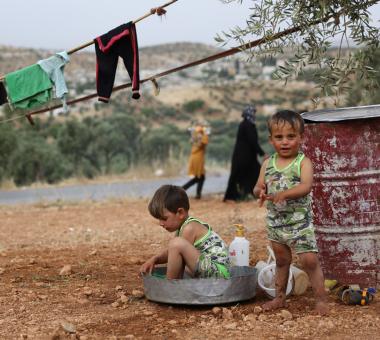
Many international organizations and institutions have created a variety of statistical indicators to measure economic, social and political fields. Every year, these indicators receive wide attention by media reports and press coverage for dealing with the relevant classifications and figures in all countries of the world.
These indicators are of great importance for the Arab world; for they are efficient at assessing the domestic policies, identifying changes and providing information about different phenomena and events. Broadly speaking, diverse indicators play a major role in policy-making, attracting investments and achieving various aspects of development; for that reason, countries of the world exert concerted efforts to achieve advanced rankings.
This article reviews a selection of global indicators, including development; sustainable development; social, political and security indicators; which would provide a clearer perspective on the Arab region and help in planning and developing appropriate strategies.
Development and Competitiveness
The world is witnessing significant dynamic changes in terms of social and economic environments, and these changes can contribute to providing better opportunities for people and achieving balance between individuals and the resources available in a given country. In this regard, the United Nations Human Development Index was created. It classifies countries according to their level of social and economic development and takes into account three main dimensions; GNP per capita, life expectancy, and weighted average for study duration. This indicator is considered one of the best measuring tools that allow tracking levels of development around the world. This indicator allows tracking levels of Arab achievement in the main dimensions of development, following up on Arab peoples and countries, and comparing them with each other, then against the world.
At the outset, United Nations data indicate that the Arab region is witnessing high human development rates. According to the 2019 Human Development Index, human development groups range from very high (0,892), high (0,759), medium (0.634), and low (0.507). In the Arab region, the average was (0.703). Despite being high, it remains less than in other regions, such as Latin America, Central Asia, East Asia, and the Pacific.
When examining the results thoroughly, we notice that there is huge difference between Arab countries, ranging from the highest ranking in the United Arab Emirates, which in 2019 ranked 35th in the world among the 189 countries included in the report, to its lowest in Yemen, which came 177th worldwide. The infographic below shows the Arab countries in the four levels of development:
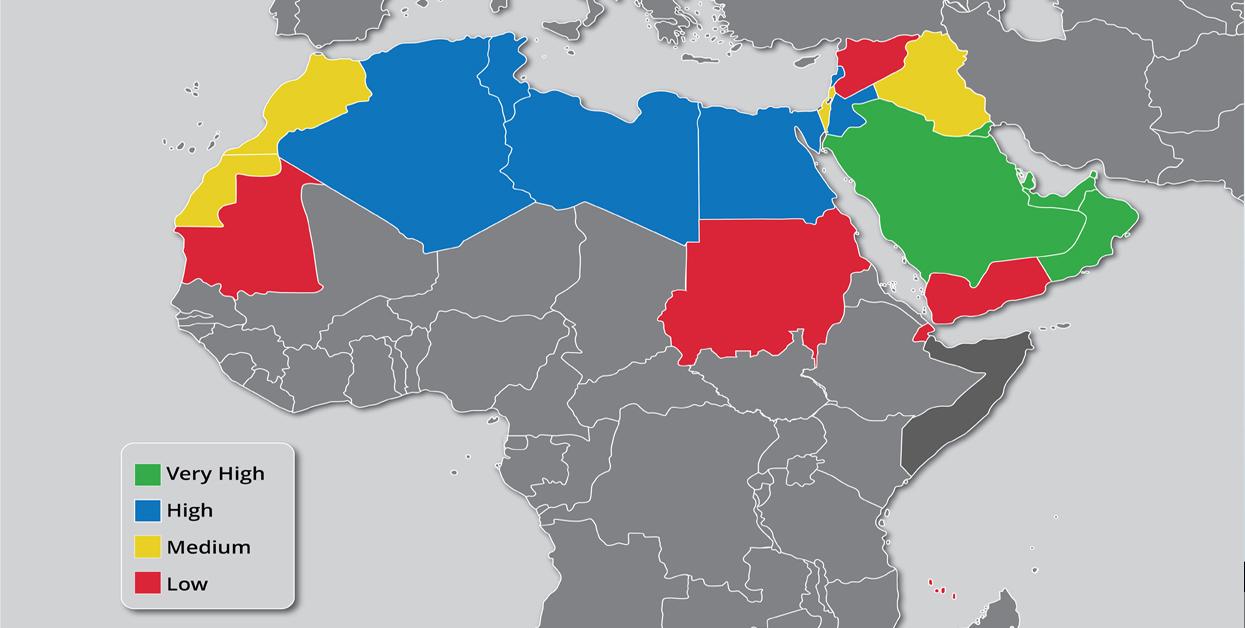
The Arab countries were ranged across the four development categories (very high, high, medium, low). All Gulf countries fall into the very high category according to the index. Algeria, Tunisia, Lebanon, Jordan, Libya and Egypt have high human development. Palestine, Iraq, and Morocco fall into the medium category, while the Comoros, Syria, Mauritania, Sudan, Djibouti and Yemen are witnessing low human development, whereas Somalia was excluded from the 2019 report.
Nevertheless, this indicator may not clarify many aspects related to the development and sustainable growth of Arab countries. As each country experiences its own demographic, political, social and legal phenomena that are different from the others, not to mention that there are special estimates for each country independent of gross domestic outcomes and broader economic forces. Therefore, touching on human development may not be sufficient to show the state of Arab economies, many of which suffer from severe pressures.
Therefore, there is a need to find a balance among human development, economic growth, and sustainable development. While human development seeks to show the status of the Arab individual, growth and development illustrate the available resources that ultimately guarantee the welfare of individuals and their standard of living. There are many international composite indicators that confirmed such a link, the most important of which is the Global Competitiveness Report issued by the World Economic Forum, which compares between 181 countries.
The report shows the positive correlation between human development and economic growth, as the countries that are ranked high in the human development index also ranked high in the competitiveness report for the year 2019, with the Gulf countries at the forefront of the Arab countries. The UAE ranked first in the Arab world and 25th in the world, followed by Qatar (29th), the Kingdom of Saudi Arabia (36th), Bahrain (45th), Kuwait (46th), and the Sultanate of Oman (53th). Most of the other Arab countries, such as Jordan, Lebanon, Tunisia, Morocco, and Egypt, remained between (70-100). Yemen was ranked second to last (140), whereas Syria and Somalia were excluded from the report.
Reading these results, we can clearly see that the Gulf states are ahead of other Arab countries, as oil appears to be a key factor in explaining such advancement. The implication may lie in the fact that countries that have huge energy resources are considered the most capable of achieving their development goals through the exploitation of financial revenues in the implementation of huge development plans. However, there are other reasons that we are meaning to mention later.
Peace and security
It is evident from the above that the Arab region is one of the most lop-sided regions in the world, as the gap between Gulf countries and other Arab countries is wide, and it is notably widening. The pressures on Arab economies are increasing, and many of them are unable to keep pace with population growth and its requirements in terms of infrastructure and other aspects of development.
Moreover, effects of conflicts in many Arab countries are clearly reflected in the indicators, especially when comparing human development rates of 2011 with that of 2019 for countries that have witnessed conflict, as shown in the table below:
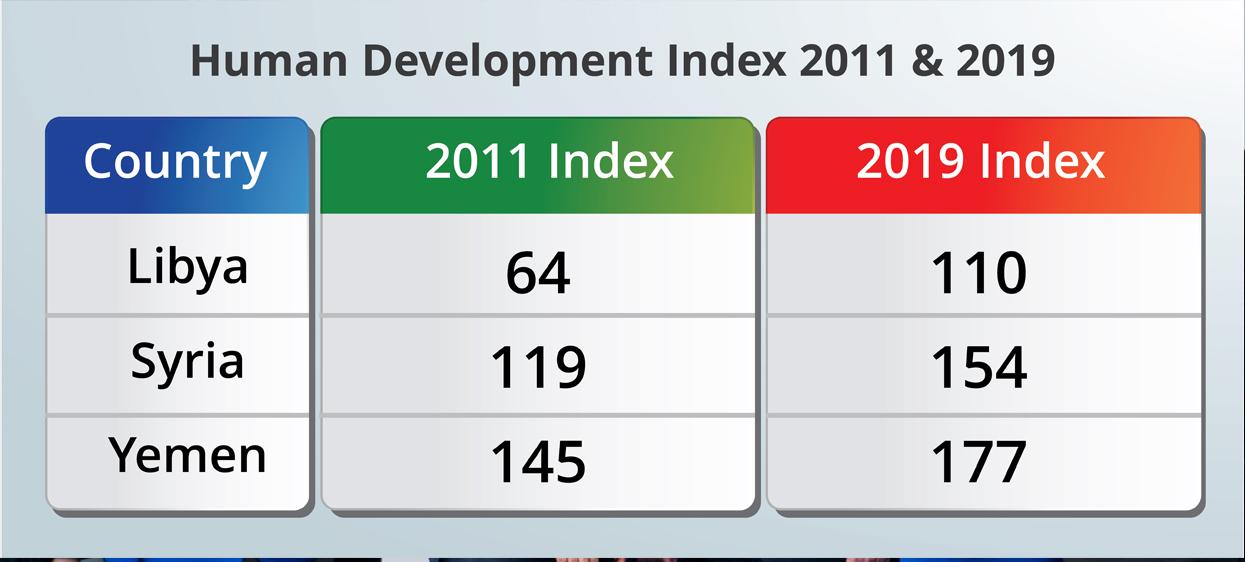
It is no secret that the regimes of these countries have recently been struggling in terms of managing their internal affairs, or even in extending central control over their entire geographical areas, not to mention the conflict between two sides for power; therefore, many of them have recently come to be described as fragile states. In this regard, a report is annually issued by the Peace Fund Foundation, referred to as Fragile States Index and includes 187 countries.
According to the index for 2020, fragile states are those that have limited capacity to manage their functions, meaning that the authorities in such countries are unable to provide services through their institutions at the economic, social and political levels.
The state of the Arab world is manifest in the index, as there are four Arab countries in the list of the ten most fragile states in the world. On the international scale, Sudan ranked (8th), Syria (4th), Somalia (2nd), and Yemen (1st), while Libya ranked 20th, and Iraq 17th. Despite the different circumstances in the aforementioned Arab countries, they share some common obstacles, which are the lack of security and the spread of the phenomenon of terrorism.
In this regard, the Arab region is often globally highlighted as a region that suffers from terrorism. Despite the relentless efforts to combat it and limit its effects, it remains the most dangerous phenomenon ever and has contributed to placing many Arab countries on the list of insecure and fragile states.
In this context, there appears to be a noticeable improvement in the global terrorism index for 2020, as terrorism-related deaths recorded a significant decrease compared to that of 2018 & 2019. In Iraq, mortality rate fell by 46% in one year - the first time that the country has recorded less than a thousand terror-related deaths since 2003. In Syria, terrorism deaths decreased by 401; in Libya by 148; and in Somalia by 77 deaths, while deaths from terrorism have increased in Yemen. Overall, the Middle East and North Africa region registered a significant improvement on the Global Terrorism Index. However, there are still four Arab countries that account for 20% of the global deaths related to terrorism, not to mention that there are four Arab countries in the list of the ten countries most affected by terrorism, as shown in the following chart:
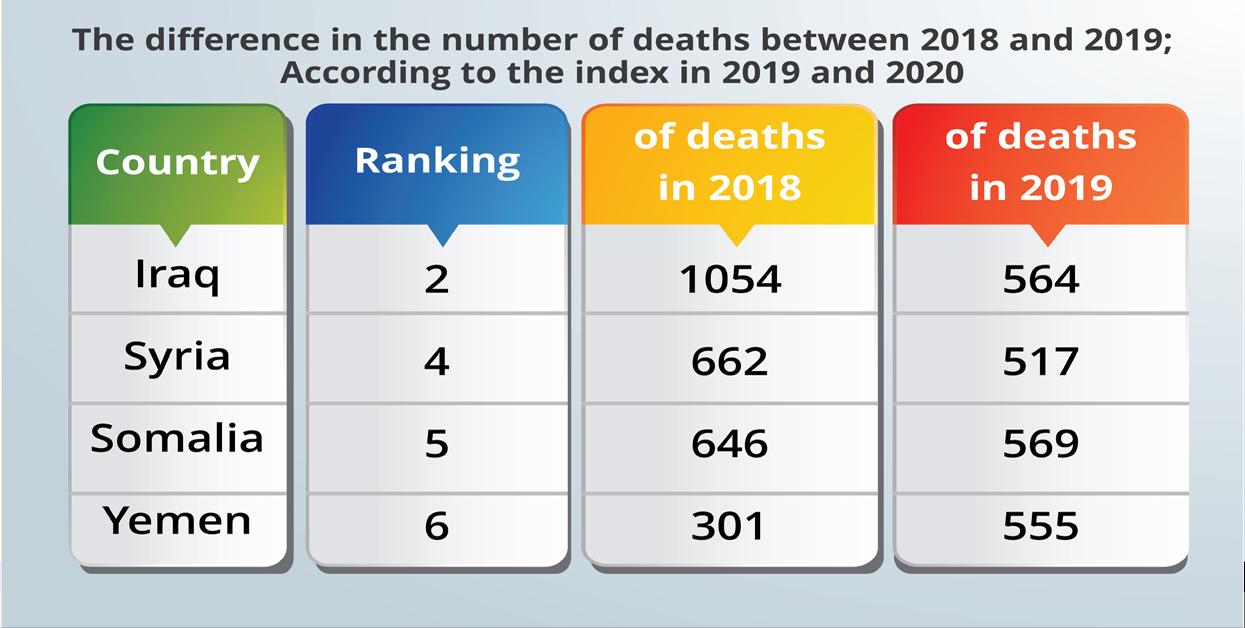
While terrorism is an undeniable part of the manifestations of violence, these countries also witness violence of a political, social and economic nature. Countries such as Yemen, Iraq, Syria, and Libya lack aspects of security and stability due to the armed and violent conflicts on their lands.
In this regard, the Global Peace Index issued by the Center for Economics and Peace ranks the countries of the world according to three main criteria; the level of social security and safety, the level of local and global conflict, and the degree of supply of military forces. In its most recent report for 2020, the Middle East and North Africa was one of the least peaceful regions in the world.
Whereas countries such as Qatar, Kuwait, and the United Arab Emirates are among the top 50 peaceful countries, Saudi Arabia has apparently retreated as a result of repeated Houthi attacks on its territories. Syria remains the second least peaceful country in the world, as millions of Syrians are either internally displaced or refugees. Iraq comes next, as it is the least peaceful country in the region, and the third in the world. Since October 2019, the country has suffered nearly 700 deaths and thousands of injuries. Then Yemen comes 159th, Libya 157th, and Sudan 153rd.
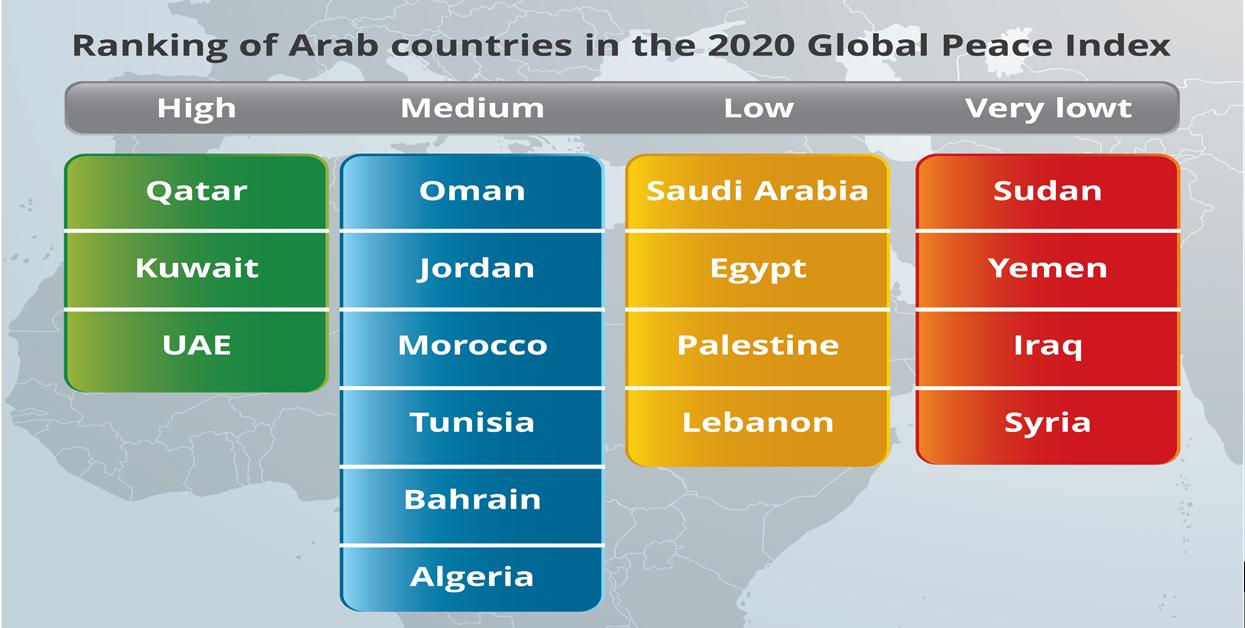
Prosperity vs. Risks
While prosperity, on the one hand, is concerned with development and sustainability in the health, educational, security, economic and political aspects, the risks, on the other, are mainly related to political and social risks and macroeconomic indicators such as public debt, institutional performance, income indicators, and others.
Weighing the two aspects, it is a common sense that strong and stable countries which face minimum risks have the potential for development and sustainability and are able to fulfill the objectives of their long-term projects. This takes us back to the first point of this report. Gulf countries come ahead of other Arab countries in terms of human development and competitiveness indicators. In other words, they have made progress at the individual level in education, income and health, and at the level of the infrastructure and institutional structures that serve these individuals. Therefore, it is undeniable that the Gulf peoples are the most luxurious and prosperous in the Arab world. According to the Global Prosperity Index 2020, the UAE ranked first, followed by Qatar, Bahrain, Kuwait, Oman, and Saudi Arabia, respectively.
On the other hand, despite the exceptional circumstances that the Arab region has witnessed in the previous decade, Gulf states maintained stability, security and internal peace. This was evident in the Global Peace Index 2020, as these countries ranked in the list of the top ten countries in the Middle East and North Africa. Therefore, it is reasonable for this stability to be reflected on economic growth and increase investments in infrastructure and other aspects. Moreover, one of the most important indicators that many investors rely on in order to determine the risks associated with investing in a country is the Global Risk Index. In 2019, Gulf countries ranked first in the list of countries with least risks in relation to the rest of the Arab countries.
According to Euromoney Country Risk Index, Syria, Mauritania, Sudan and Yemen ranked last among the Arab countries. This shows how strong is the link between the importance of achieving security and peace for these societies and their ability to achieve the foundations and factors of development and sustainability.
Based on the above, it is clear that there is a great disparity among countries in the Arab world. Gulf countries are far ahead of other Arab countries due to the security and stability they enjoy, which in turn increase their chances of economic growth and investments.
Such a deep gap has a great impact not only on domestic affairs, but also on the global aspect. For it makes it difficult for Arab countries to achieve unity and integration similar to the European Union, not to mention that it weakens the role assigned to the Arab League and other Arab organizations and makes Arab international relations tend towards unilateralism without adopting a unified Arab stance. On the other hand, this gap broadens the scale of the negative phenomena already prevalent in the Arab countries, as of terrorism; for the impact of events in Syria and Iraq in general has moved outside their borders, in addition to the displacement and asylum crises, the increase in security costs and the loss of benefits from bilateral trade, in addition to many other effects on different Arab states.
Meanwhile, there is a need to achieve broader Arab cooperation in the region's efforts to break out of the cycle of conflict and violence towards greater stability and peace. Although the indicators show that Arab region is witnessing acceptable levels of development and competitiveness, there is a victory that must be achieved against the phenomenon of terrorism. Peace and stability should also be pursued in a region that is rife with challenges at all political, social, security and economic levels.

STRATEGIECS Team
Policy Analysis Team
 العربية
العربية